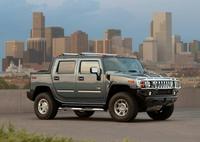HUMMER H2 SUT Sports Lightweight Nanocomposite Material
WARREN, Mich. May 13, 2004; There's more to the 2005 HUMMER H2 SUT than its reconfigurable open cargo bed. The functional and versatile SUT is the latest vehicle in General Motors Corp.'s line-up to benefit from a lightweight, high performance nanocomposite material.
The H2 SUT cargo bed uses about seven pounds of molded in color nanocomposite parts for its trim, center bridge, sail panel and box rail protector.
"The beauty of the HUMMER H2 SUT is its ability to go pretty much anywhere off-road and in all types of conditions," said Bill Knapp, H2 program engineering manager. "We designed this vehicle to use the nanocomposite parts because they are lightweight, and they don't change shape when subjected to temperature changes, which enhances the overall quality of the vehicle."
GM introduced the first commercial automotive exterior application of nanocomposite material on the step assist of the 2002 GMC Safari and Chevrolet Astro vans. In January 2004, GM expanded its use of nanocomposite material, introducing it on the body side molding for the '04 Chevrolet Impala. GM is now using about 660,000 pounds of nanocomposite material per year, which is the highest volume of olefin- based nanocomposite material used in the world.
Compared to conventional fillers, the size of the nanofiller is on the molecular scale, a thickness of one-billionth of a meter, or about 1/100,000 the width of a human hair.
"The virtue of using a nanocomposite for automotive applications is that less filler material is required to provide the same or better performance characteristics when compared to conventional materials," said Will Rodgers, Staff Scientist, GM Research and Development. "Our next applications for nanocomposite materials will be in exterior claddings, interior parts and in non-support trim," said Rodgers.
The nanocomposite material used on GM vehicles is the product of advanced scientific research at the GM Research & Development Center in Warren, Mich. and an exclusive GM development agreement with Basell USA Inc., the world's largest producer of polypropylene resin for plastics and Southern Clay Products, Inc., a high quality nanoclay supplier, of Gonzales, Texas. GM successfully developed the chemistry necessary to achieve all the positive attributes for the nanocomposite material. Basell developed the technology necessary to industrialize the new material within Basell's manufacturing facilities. Southern Clay Products worked with GM to provide a nanoclay that would disperse in an olefin based material.
The parts are molded at Sport Rack Automotive in Sterling Heights, Michigan, and assembled at the HUMMER plant in Mishawaka, Indiana.
General Motors Corp., the world's largest vehicle manufacturer, employs about 325,000 people globally. Founded in 1908, GM has been the global automotive sales leader since 1931. GM today has manufacturing operations in 32 countries and its vehicles are sold in 192 countries. In 2003, GM sold nearly 8.6 million cars and trucks, about 15 percent of the global vehicle market. GM's global headquarters are at the GM Renaissance Center in Detroit. More information on GM and its products can be found on the company's corporate website at www.gm.com.



